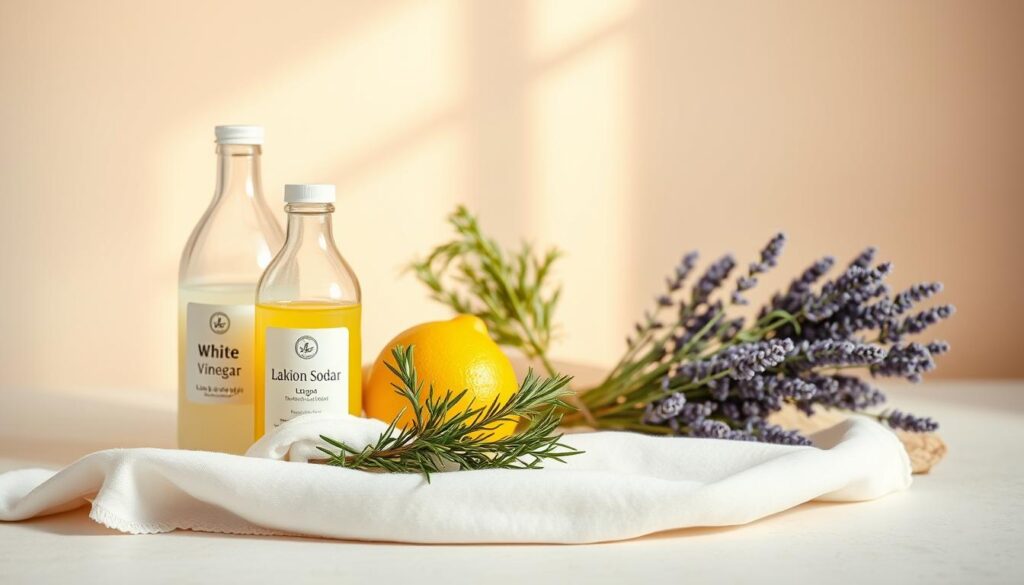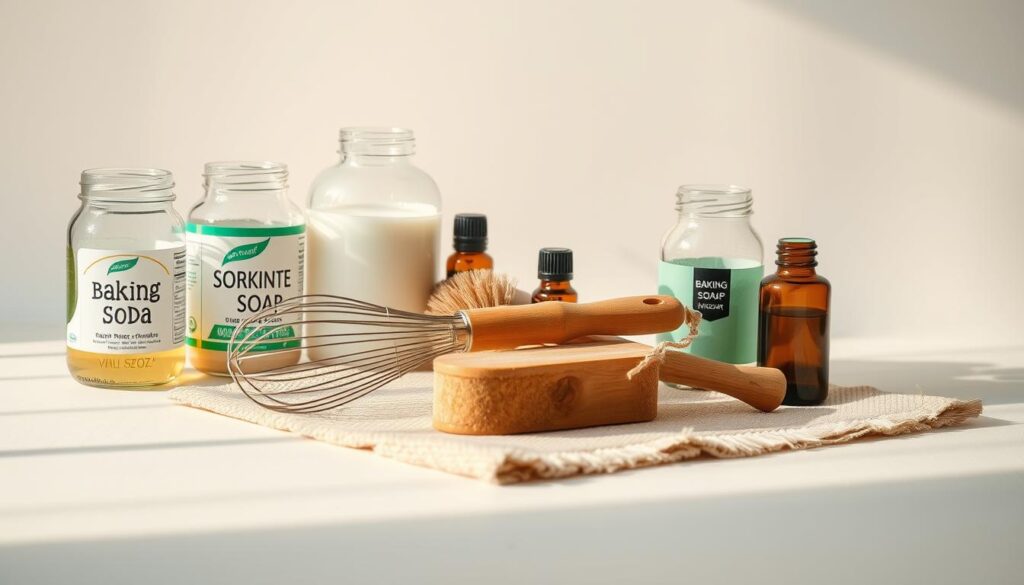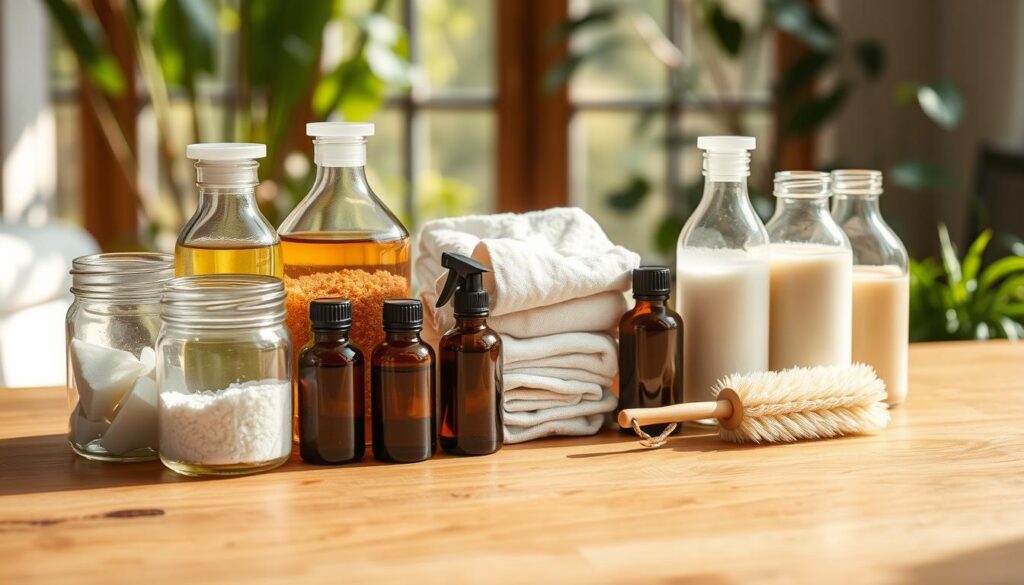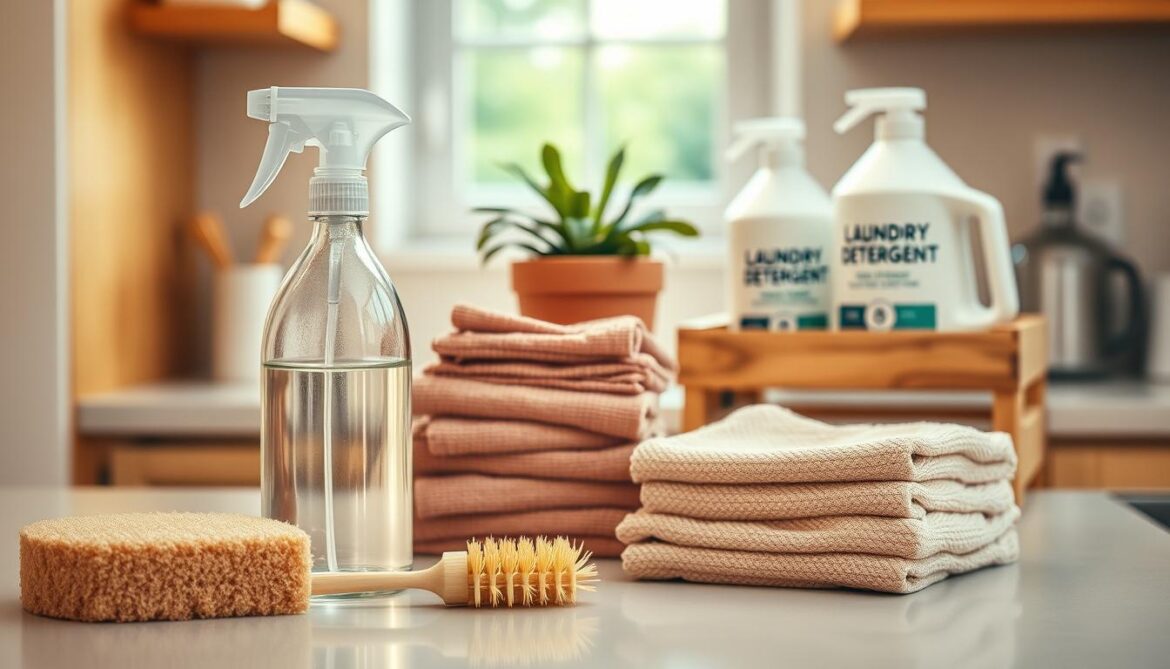What if you could clean your house effectively while protecting your family’s health and the planet? Sustainable living expert Stephanie Moram puts it best: “There has to be a better way to clean our homes—one that doesn’t involve harsh chemicals or endless waste.” The solution lies in rethinking everyday routines, starting with what you already have in your pantry.
Traditional cleaning products create 3 billion pounds of plastic waste yearly in the U.S. alone. By switching to reusable tools like Swedish dishcloths—which replace 17 rolls of paper towels on average—you’ll cut clutter and save $150+ annually. These cloths work wonders paired with simple ingredients: 1 cup water + 1 cup white vinegar tackles grease, grime, and odors naturally.
Families who adopt these habits report fewer allergy flare-ups and respiratory issues. You’ll also avoid the “chemical cocktail” effect of mixing store-bought cleaners. As Moram notes: “Your kitchen holds everything you need for a sparkling home—no specialty products required.”
Ready to dive deeper? We’ll walk through room-specific strategies and DIY recipes that keep your space fresh without compromising safety or sustainability.
Key Takeaways
- Swapping paper towels for reusable cloths saves money and reduces waste
- Basic ingredients like vinegar and water handle most cleaning tasks
- Eco-friendly methods lower exposure to harmful chemicals
- Sustainable habits prevent 3 billion pounds of annual plastic waste
- Swedish dishcloths replace 17+ paper towel rolls per year
Understanding Eco-Cleaning Basics
Did you know 78% of conventional cleaning products contain undisclosed “fragrance” chemicals linked to respiratory issues? This hidden reality drives the shift toward greener methods. Eco-friendly cleaning means using solutions that protect both your home and ecosystems—without compromising effectiveness.

What Makes a Cleaner Truly Green?
The Sustainable Home Magazine defines eco-cleaning by three rules: non-toxic ingredients, reusable tools, and minimal plastic waste. Check labels for plant-based formulas and avoid mystery “fragrance” listings. Detergent sheets, for example, use 90% less packaging than liquid alternatives.
Why Your Switch Matters
Traditional sprays often release volatile organic compounds (VOCs) that linger in your house. A 2023 EPA study found homes using natural cleaners had 54% lower indoor air pollution. Simple swaps like vinegar–water mixes eliminate harsh chemicals while cutting costs.
| Traditional Products | Eco Alternatives | Impact Difference |
|---|---|---|
| Chemical-laden sprays | Vinegar solutions | No respiratory irritants |
| Plastic bottles | Reusable glass containers | 72% less waste |
| Synthetic fragrances | Essential oil drops | Safer for allergy sufferers |
These changes create ripple effects. You’ll breathe easier while keeping 17+ pounds of plastic out of landfills yearly per household. Ready to mix your first batch? Next, we’ll explore pantry staples that outperform store-bought cleaners.
Essential Eco-Cleaning Ingredients & Tools
Your kitchen holds secret weapons that outperform most store-bought cleaning products. The Sustainable Home Magazine reveals: “Three pantry staples handle 90% of household grime while costing pennies per use.” Let’s explore these power players and the reusable tools that amplify their impact.

Nature’s Triple Threat: Vinegar, Baking Soda, Lemon
White vinegar dissolves mineral deposits when mixed with water (1:1 ratio). Add lemon juice for fresh scent and extra grease-cutting power. Baking soda scrubs surfaces without scratching—sprinkle it on sinks or mix with water (½ cup each) for a paste that lifts stains.
These ingredients work smarter together. A 2023 study found vinegar-baking soda solutions remove 89% of bacteria from countertops. Lemon’s acidity breaks down soap scum in showers naturally.
Tools That Outlast Paper Towels
Swap disposable paper towels for Swedish dishcloths—one replaces 17 rolls yearly. Their cellulose fibers absorb 20x their weight in water, perfect for spills or window cleaning. Machine-wash them 100+ times before composting.
Pair these with:
- Glass spray bottles (lasts 5+ years)
- Plant-based scrub brushes (biodegrade in 6 months)
- Microfiber cloths for dusting (washable 300+ times)
This toolkit slashes waste while keeping your home spotless. As one user reports: “I’ve saved $217 this year just by ditching single-use products.” Ready to mix your first batch?
How to Make Your Own Eco-Friendly Cleaning Products
Your spice rack holds more power than you realize. With three common ingredients, you can mix cleaning products that outperform store-bought sprays while costing just 8¢ per bottle. Let’s transform your home into a DIY lab where safety meets savings.

DIY All-Purpose Cleaner and Disinfectants
Start with this all-purpose cleaner recipe from Sustainable Home Magazine:
- Mix ¾ cup water + ¼ cup white vinegar in a glass spray bottle
- Add 10 drops of essential oils (tea tree or lavender work well)
- Shake before each use—spray on surfaces and wipe clean
For disinfecting high-touch areas like doorknobs:
- Combine ½ cup hydrogen peroxide + ½ cup water
- Let sit 5 minutes before wiping—kills 99% of germs naturally
Simple Recipes Using Water, Vinegar, and Essential Oils
Conquer stubborn stains with this duo:
- Baking soda paste: Mix ½ cup baking soda + 3 tbsp water until spreadable
- Scrub grout or oven surfaces, then rinse
Pro tip: Add lemon juice to vinegar solutions to mask the sour smell. One user shared: “I add orange peels to my cleaner jar—it smells like sunshine!”
Always store hydrogen peroxide separately from vinegar mixes. When combined, they create irritating peracetic acid. These recipes slash packaging waste by 80% compared to plastic-packed products. Your wallet wins too—a year’s supply costs less than $15.
Implementing a Sustainable Cleaning Routine in Every Room
Your morning coffee ritual could hold the key to a greener cleaning routine. Let’s explore practical strategies for high-traffic zones like the kitchen and bathroom—where small changes create big impacts. According to Sustainable Home Magazine, switching to reusable cloths in these areas prevents 23 pounds of plastic waste annually per household.
Room-by-Room Tactics That Add Up
Start with paper towel alternatives: Keep 2 Swedish dishcloths near the sink and 1 in the bathroom. These absorb 20x their weight in water, perfect for wiping counters or drying shower doors. A real-life example from the web_source shows families save $4 monthly by using these instead of disposable paper towels.
For countertop cleaning, mix 1 cup vinegar with 1 cup water in a glass spray bottle. Add lemon peel for freshness—this cuts grease faster than most store-bought products. Refill stations at local shops let you reuse detergent bottles 50+ times, slashing plastic use by 80%.
| Area | Traditional Tool | Eco Swap | Yearly Savings |
|---|---|---|---|
| Kitchen Sink | Disposable sponges | Plant-based scrub brush | $37 |
| Bathroom | Antibacterial wipes | Microfiber + vinegar spray | $52 |
| Floors | Single-use mop pads | Washable cotton pads | $29 |
Organize your routine with a weekly schedule. Mondays: Scrub sinks with baking soda paste. Thursdays: Refresh showerheads using ½ cup vinegar soak. Sundays: Refill spray bottles at bulk stores. One Portland family reported: “We cut our cleaning products budget by 60% in three months!”
For bathrooms, combine ½ cup baking soda with 10 drops tea tree oil to disinfect tiles naturally. Store mixes in labeled glass jars—they look tidy and prevent chemical reactions. Sustainable Home Magazine notes: “Consistency beats perfection. Even replacing 30% of disposables makes your house healthier.”
Wrapping Up Your Journey to a Greener Home
Every choice you make in your cleaning routine creates ripples—for your family’s health and the planet’s future. As Sustainable Home Magazine reminds us: “A sparkling home doesn’t require harsh chemicals—just smart habits.” Those Swedish dishcloths replacing 17 paper towel rolls? They’re part of a bigger picture where small steps slash waste and boost wellness.
Stick with your DIY recipes like the 1 cup vinegar + water mix. Proper measurements matter—too much baking soda weakens grout cleaners, while precise essential oils ratios maximize freshness. Track progress by weighing recycled plastic monthly; many families eliminate 23+ pounds yearly.
Share your wins! Did swapping sprays for lemon juice solutions ease allergies? Post photos of labeled glass jars holding all-purpose cleaner. Tag #GreenHomeStories to inspire others. Remember: cleaning products shouldn’t cost the Earth—literally or figuratively.
Your journey proves daily choices hold power. One reusable cloth. One refilled bottle. Together, we’re building healthier surfaces, cleaner air, and communities thriving through sustainable life practices. What’s your next step?
FAQ
How much money can I save by switching to DIY eco-cleaners?
FAQ
How much money can I save by switching to DIY eco-cleaners?
Most households save 0-0 annually by replacing commercial products with DIY solutions. A basic all-purpose cleaner costs under
FAQ
How much money can I save by switching to DIY eco-cleaners?
Most households save $300-$500 annually by replacing commercial products with DIY solutions. A basic all-purpose cleaner costs under $0.50 per 16oz bottle (1:1 water and white vinegar + 10 drops essential oil) versus $5-$8 for store-bought versions.
Are vinegar-based cleaners safe for granite countertops?
Avoid vinegar on natural stone surfaces like granite or marble – the acidity can etch finishes over time. Use baking soda paste (3 parts water to 1 part baking soda) for scrubbing instead. For disinfecting, opt for hydrogen peroxide spray (3% solution).
What’s the most effective reusable alternative to paper towels?
Swedish dishcloths absorb 20x their weight and last 6-9 months with proper care. Machine-washable cotton bar mops (like those from Casabella) or repurposed t-shirt rags also work well. Bonus: This swap reduces paper waste by 80% for most families.
Can essential oils replace chemical disinfectants?
While oils like tea tree and lemon have antimicrobial properties, they’re not EPA-registered disinfectants. For high-risk areas (toilets, cutting boards), combine ½ cup hydrogen peroxide + ½ cup water + 20 drops tea tree oil. Let sit 5 minutes before wiping for best results.
How do I prevent mold in reusable spray bottles?
Clean bottles weekly with hot soapy water. For stubborn residues, soak in 1 cup white vinegar + 2 tbsp baking soda solution. Store DIY cleaners in amber glass bottles (like BlueSky Basics) to inhibit bacterial growth between uses.
What’s the fastest way to eco-clean a greasy stovetop?
Sprinkle baking soda on cool surfaces, spray with 50/50 water-vinegar solution, then scrub with a Dobie scrub pad. For burnt-on grease, add 1 tsp Castile soap to the mix. Rinse with a damp microfiber cloth – no harsh chemicals needed.
.50 per 16oz bottle (1:1 water and white vinegar + 10 drops essential oil) versus – for store-bought versions.
Are vinegar-based cleaners safe for granite countertops?
Avoid vinegar on natural stone surfaces like granite or marble – the acidity can etch finishes over time. Use baking soda paste (3 parts water to 1 part baking soda) for scrubbing instead. For disinfecting, opt for hydrogen peroxide spray (3% solution).
What’s the most effective reusable alternative to paper towels?
Swedish dishcloths absorb 20x their weight and last 6-9 months with proper care. Machine-washable cotton bar mops (like those from Casabella) or repurposed t-shirt rags also work well. Bonus: This swap reduces paper waste by 80% for most families.
Can essential oils replace chemical disinfectants?
While oils like tea tree and lemon have antimicrobial properties, they’re not EPA-registered disinfectants. For high-risk areas (toilets, cutting boards), combine ½ cup hydrogen peroxide + ½ cup water + 20 drops tea tree oil. Let sit 5 minutes before wiping for best results.
How do I prevent mold in reusable spray bottles?
Clean bottles weekly with hot soapy water. For stubborn residues, soak in 1 cup white vinegar + 2 tbsp baking soda solution. Store DIY cleaners in amber glass bottles (like BlueSky Basics) to inhibit bacterial growth between uses.
What’s the fastest way to eco-clean a greasy stovetop?
Sprinkle baking soda on cool surfaces, spray with 50/50 water-vinegar solution, then scrub with a Dobie scrub pad. For burnt-on grease, add 1 tsp Castile soap to the mix. Rinse with a damp microfiber cloth – no harsh chemicals needed.

